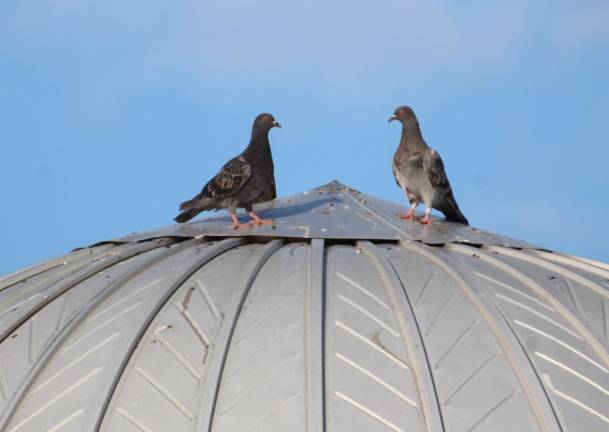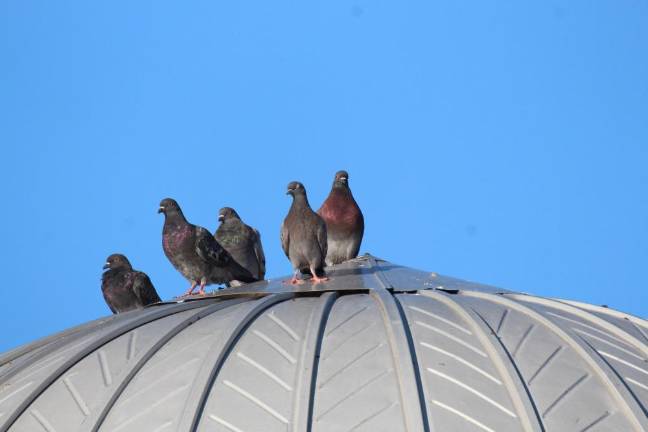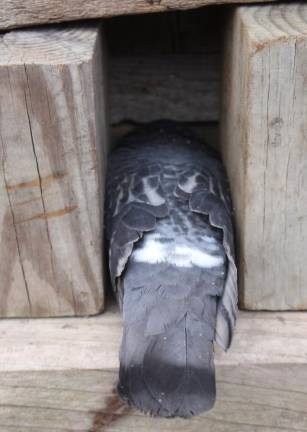Requiem for the silo pigeons
At first, the farmer didn’t want them around. But over the decades, he came to admire the sustainable – but fragile – community living overhead.




When we moved to our farm there were 20 or more pigeons living in the upper barn and three half-feral cats still hanging out in the milking parlor below. The pigeons gained entry under the overhanging eaves of the metal roof. When the barn was packed with hay there would not have been much room to fly about, but it was a safe place for the birds to roost at night and offered good cover from wind, rain and snow. Maybe they even came across a few seeds to eat in the stacked hay.
Once the dairy cows were gone and, with them, any reason to hold thousands of bales of hay each winter, the upper barn was given a new purpose. My wife, Flavia, laid claim to one third of the available space for use as a painting studio. The rest fell to me. I converted it into a workshop and place to store supplies for my budding vegetable growing enterprise. Roosting pigeons and their prodigious nighttime droppings soon became an issue. Not being a big fan of pigeons at that time, nor willing to tolerate their droppings on my stuff, I set about blocking their access with strips of wood and chicken wire. It was 35 years ago but I still recall spending a lot of time on an extension ladder.
Deprived of their accustomed roosting quarters, the pigeons, or at least some of them, moved to the silo which had become empty and available. They got in through an opening at the top of the silo’s dome and spent their nights on the concrete block rim just below. Perhaps because there was less roosting and nesting space, the pigeon population soon dropped from the initial 20 or more to around a dozen. Until very recently, it remained remarkably stable. At the end of a day, one could invariably see several pigeons standing on the dome of the silo, taking in the last rays of sun before retiring for the night.
City dwellers (I was once one) tend not to be great lovers of pigeons. Perhaps because there are so many of them — pigeons, that is. Their numbers, of course, pale when compared to human populations. In contrast to most other birds, city pigeons seem to have little fear of the human species. They often mob us, especially when we are enjoying a sandwich on a park bench. They make it clear they think the sandwich should be shared with them, if not offered in its entirety. Once it’s finished, they quickly move on, with not so much as a wink of gratitude, looking only for the next potential human food source. Some people enjoy sharing their sandwich with pigeons, but most prefer eating the whole thing.
Pigeons are also atypical amongst birds in that they generally do not perch in trees. Their feet and toes are shorter and not well suited to gripping rounded branches. They are more comfortable on window ledges and other elevated, shelf-like surfaces that resemble the rocky cliffs in Europe, North Africa and parts of Asia where the birds first found their footing millions of years ago. From a human point of view, this roosting preference is problematic. It results in accumulations of pigeon poop which, because of its high acidity, can, over time, eat away at concrete and even metal. If you try to clean it off your windowsill, wear a mask. Inhalation of dust resulting from aged pigeon droppings can lead to serious lung diseases. Two more strikes against them. To be fair, though, one should acknowledge a redeeming feature of these urban birds. A bit like vacuum cleaners, they do a good job of picking up food scraps left lying around by careless members of our own species.
Unlike their city cousins, our farm pigeons are quite shy of humans. They do not congregate around us looking for handouts and they fly away when we get too close. Their diet consists of assorted seeds, grains, fruits and nuts, along with the occasional grasshopper or earthworm. In the winter, when pickings are slim, they will take leaves and grasses for sustenance and even acorns that are not already snatched up by the farm’s other wild residents.
After many years of accommodating pigeons, the floor of the silo, nearly 40 feet below where the birds roost at night, has become a repository of pigeon guano almost a foot deep. Guano is generally defined as the excretory deposits and broken shells of large colonies of sea birds. It makes a potent, high nitrogen plant fertilizer. When accumulated over time and not subjected to rain or snow, pigeon poop does the same. Thus far, we have not used this natural resource to enhance soil fertility, but I expect that day will come. When it does, I’ll be sure to wear a respirator or good dust mask before entering the rather dark, dank and forbidding silo.
Over many years living alongside them, I’ve grown to admire these birds and their ways – to approve of their stable population and sustainable use of the resources at their disposal. I’ve never observed conflict among them. They do not cause us any trouble, nor have they ever shown an interest in eating our vegetables and fruit. Frequently, they can be seen in the fields foraging for weed seeds, a practice of which we approve. These pigeons seem to fit nicely into a larger farm ecology, even if they are obliged to provide a meal for a raptor or fox now and then.
It is with regret that I must now report that, for some as-yet unknown reason, the farm’s pigeon population appears to have recently plummeted. While writing this story, I’ve been keeping an eye out for them over the past week or so. I’ve not seen more than two, even when shining a flashlight into the silo at night. This past winter, on a cold, windy day, I was surprised to notice a small pigeon nestled between a few 4-by-4-inch wood blocks on the ground. I thought it was trying to stay out of the wind but when I reached down to touch it, I realized it was dead. I don’t know why.
We take life for granted, assuming it will always be here. After 35 years, the near disappearance of the silo pigeons reminds me of the impermanence of things, the coming and the going, the tentative hold of life, of everything in existence, even ourselves.